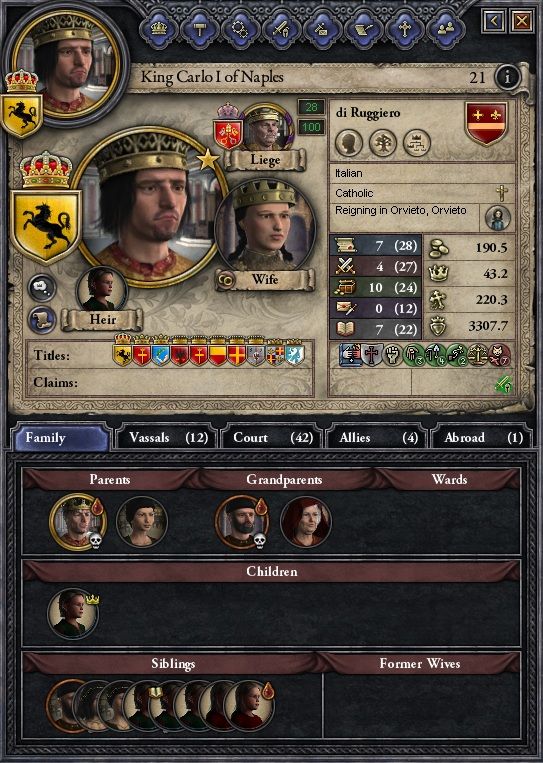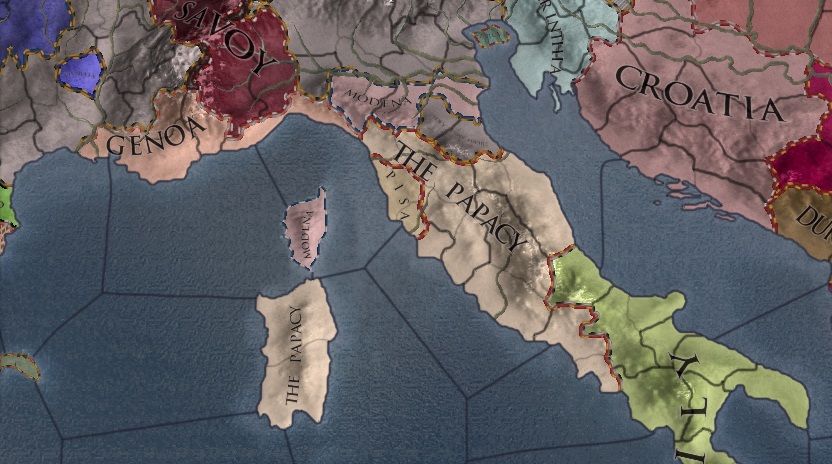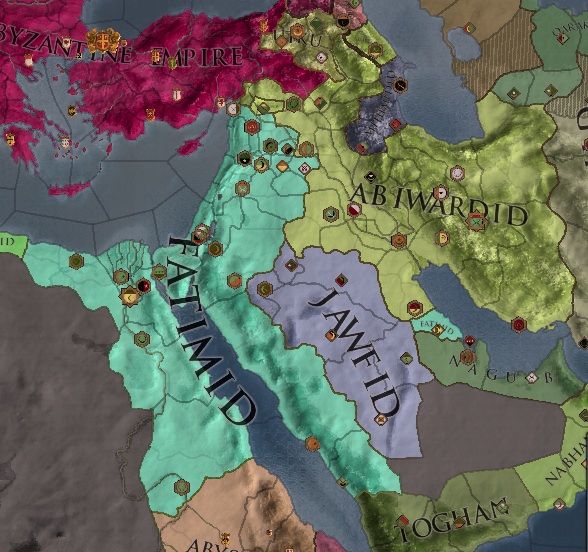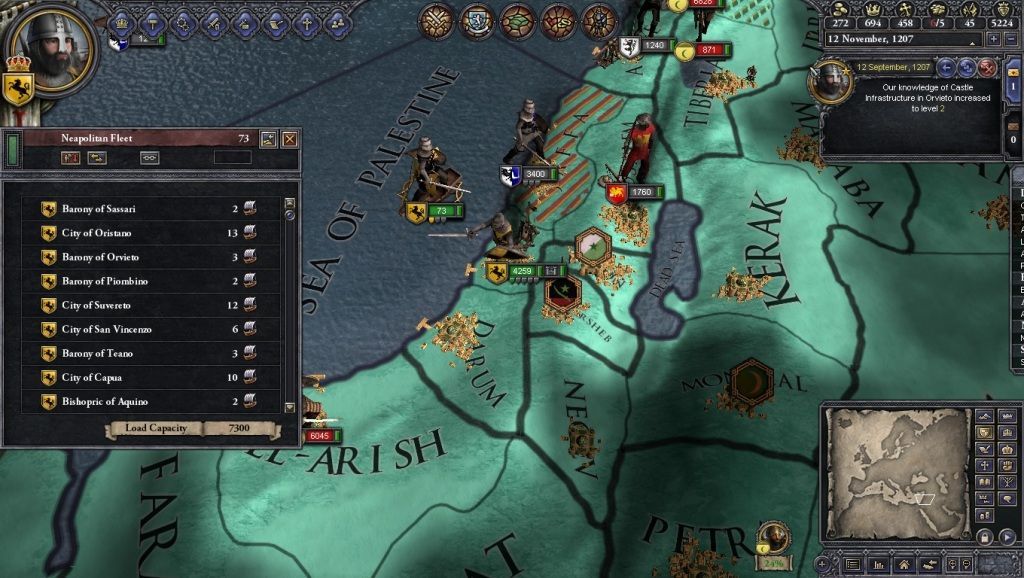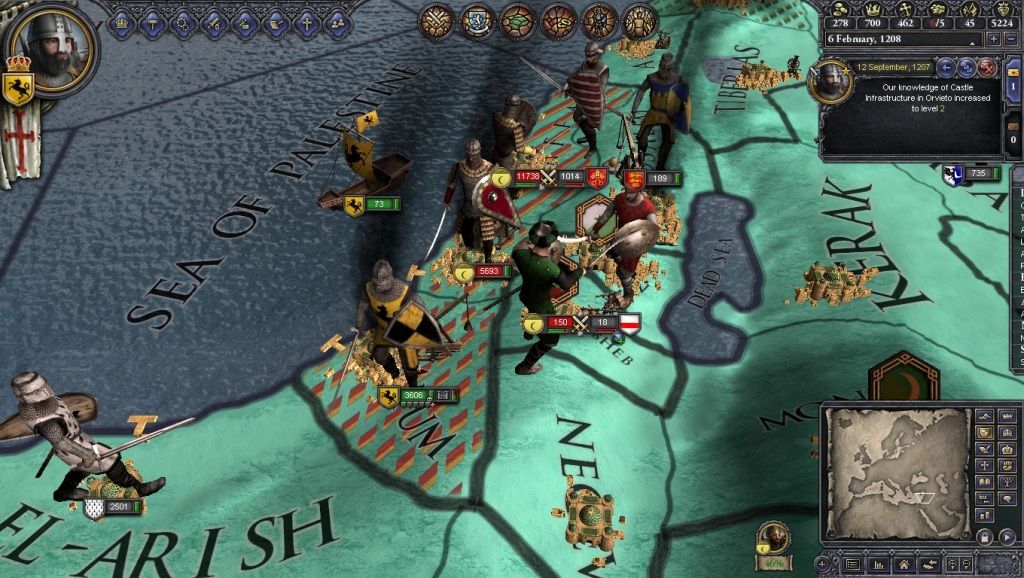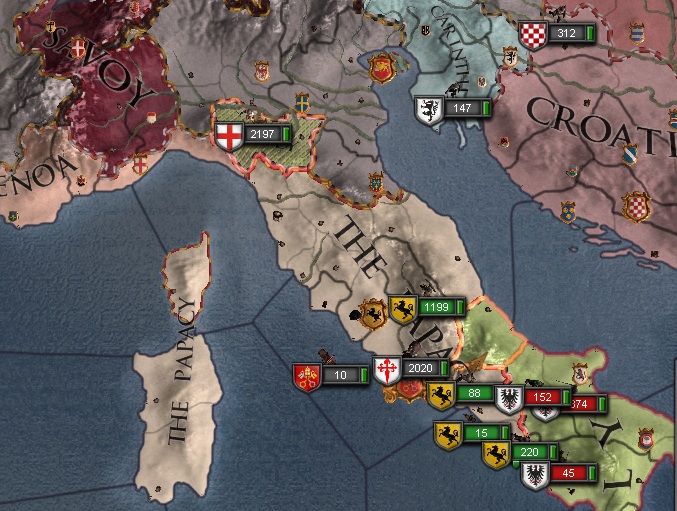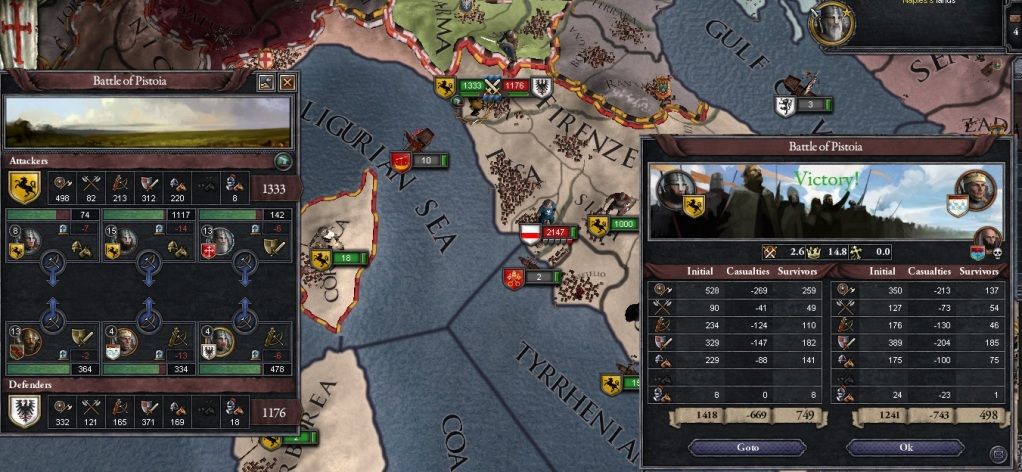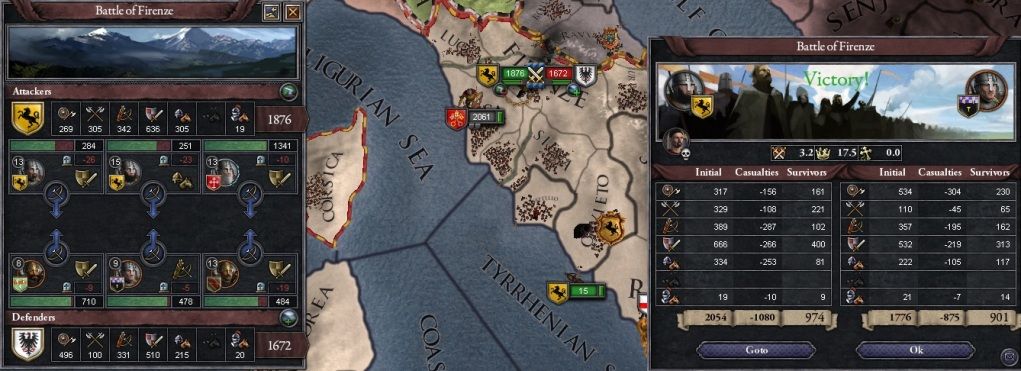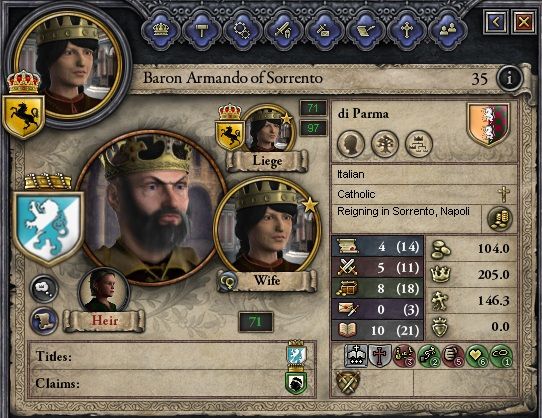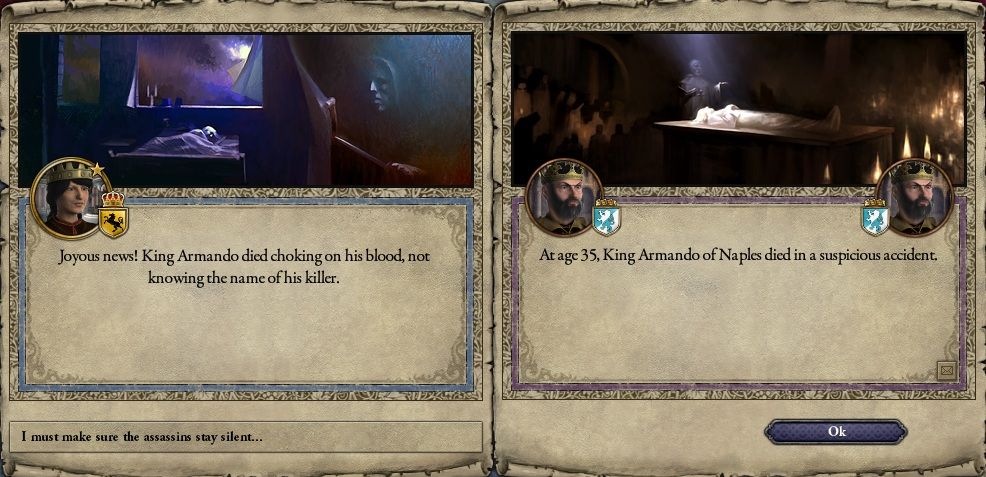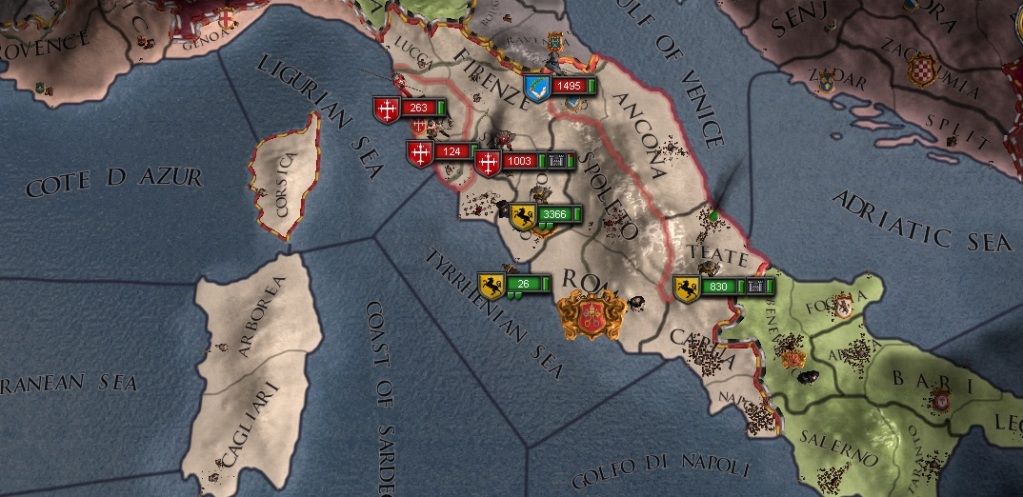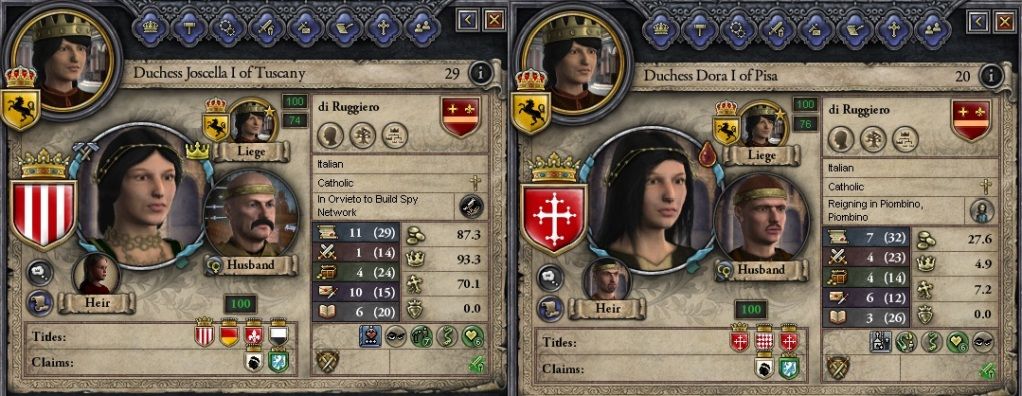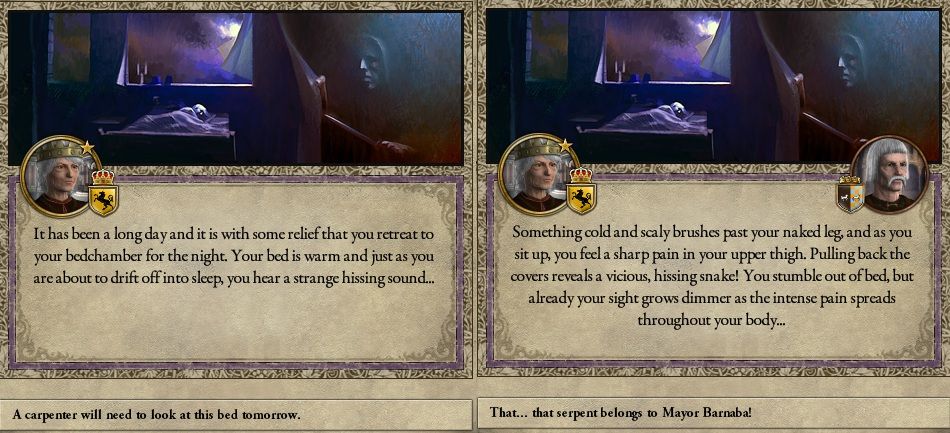April 1200 - September 1201
Italy Split in Three
The Arrival: April 4, 1200
King Carlo II sat upright at his table, reviewing a letter from his brother Benito across the sea on the island of Sardinia. In it, Benito expressed his thanks for Carlo's assistance in capturing Corsica, completing the Duchy of Sardinia which was given in its fullness to Prince Benito. It had been an easy campaign, and Carlo wanted to be sure that Benito, his only full-blooded brother, had a strong enough power base to support him in wayward claimants decided to challenge the throne. Carlo I had been a busy man, fathering a total of twelve children with three wives -- his first died in a suspicious accident which was never proven of any wrongdoing, and his second died a natural death, and with his third wife he continued to sire children even into his 50's. There were no shortage of blood relations to the late King, and Carlo was cautious of them.
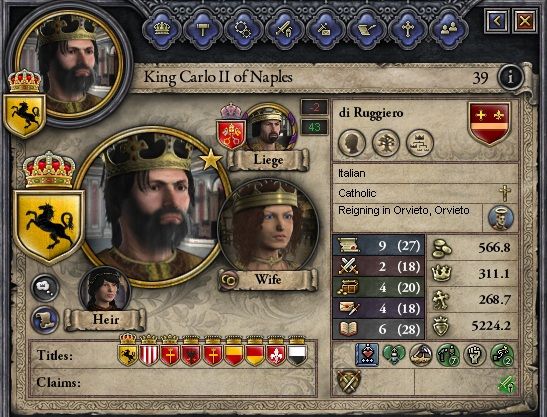
As he read, the loud and repeated tolling of the church bells atop the cathedral in Narni caught Carlo's attention, and jarred it away from the letter and the thoughts of his brother. Rising quickly from his table, Carlo threw his cloak across his shoulders and beckoned with a sharp wave of his hand to his uncle and Marshal, Prince Vittorio.
“Come, Vittorio. They have arrived.” he spoke simply, with grim determination.
Leaving the castle and riding as fast as his choice horses would carry, Carlo galloped into the City of Narni, the streets clearing to either side as the peasants scattered to allow their king passage. As the horses charged through the city, the other smaller churches of the city chimed in, a chorus of bells, each on slightly different pitches, ringing out at once. Carlo looked out toward the city harbor, and saw the large ship crashing throgh the waves of the Tyrrhenian Sea and approaching the nearest dock. The large, white sail atop the vessel was marked with a red Cross of Saint James, signalling its allegience: the Knights of Santiago had arrived.
As the ship docked and its passengers began to disembark, he saw the figure of the Order’s Grandmaster, Benito de Alagon, escorted by his retainer knights on either side. Benito’s figure was aged -- the man was 59 years old, and he was somewhat slow to walk as he approached with his entourage, and King Carlo stepped forward from his own bodyguards to greet him. Aged or not, the man was the Grandmaster of the Order of Santiago, and with a sharp military mind, was every bit as deadly as a man half his age commanding the same troops.
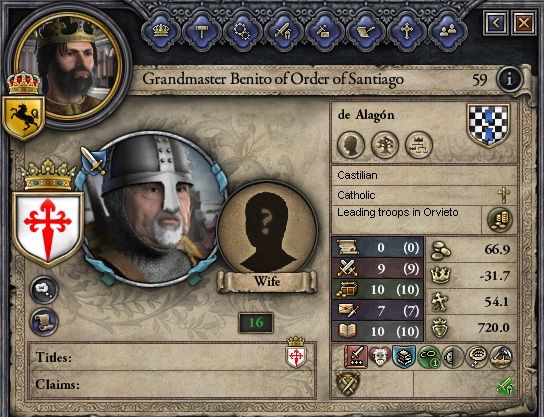
“Lord keep you, Your Highness,” the Grandmaster greeted Carlo. His words were formal and held a tone of respect, but his body language, offering nothing more than a stiff, curt nod, clearly communicated that Benito’s loyalty was to God and to the Holy War, not to any earthly king, no matter how pious. The defiant stint would have drawn Carlo’s anger from an ordinary man -- but the leader of an order of holy knights held an altogether different air of authority.
“I trust your journey here was safe,” Carlo responded, looking up to the other ships gradually making their way into the dock, “You have my gratitude, as well as the thanks of all the God-fearing people of Naples for answering our call.”
“You were wise to call upon us,” said Benito with another stiff nod, “We exist not only to fight the Mohammedan scourge... But our blades are divinely ordained to cut down any who violate the true faith... As it seems the despicable heretics in Pisa have done.”
“A most foul heresy, indeed,” spoke the 60 year-old Court Chaplain of Naples, Bishop Basso of Aquino, stepping just behind his liege, “The Fraticelli movement has surfaced here and there in Italy before, but now the shameful Doge Bartolomeo has embraced the heresy as his own! They would deny the Church the wealth and glory due to her, and see her whore away her majesty to feed the poor. Such a misguided notion of charity would surely destroy Holy Mother Church, if left unchecked.”
A pair of senior knights approached the group, speaking a few hushed words to Grandmaster Benito, before receiving their instructions and directing the unloading of the rest of the knights and their supplies.
“What can you tell us about our opponents, my King?” the Grandmaster asked.
“Allow me, Highness,” interjected Marshal Vittorio, “The Republic of Pisa is small, consiting of only two Counties. But they command an impressive amount of wealth, and will be able to field an army of substantial size. We have already issued the call to arms for our own soldiers -- within two weeks, we should have the majority of our forces mustered here and ready to go to battle. If we can outmaneuver and defeat them in the field, laying siege to their lands will not be difficult.”
“Very well,” Benito answered, changing his tone as he began to issue commands, “My Knights will form the center flank of the army. Marshal, I will charge you and whoever you deem most capable with supporting the flanks. May God guide our blades, and may we water the Church in Pisa with the blood of her heretic foes.”
The Assault: June 3, 1200
The scent of incense hung heavily in the air as the priests who had accompanied the armies of Naples on their journey walked along the battle lines to offer their blessings. At the front of the formation, Bishop Bertoldo di Ruggiero, the leader of the churches in Siena, delivered his pre-battle blessing, praying aloud in a shout as he read from the hundred and forty-third Psalm.
“Blessed by the Lord my God, who teacheth my hands to fight, and my fingers to war!” he called out, his voice booming through the formation of men, “My mercy, and my refuge, my support, and my deliverer, My protector!! And I have hoped in Him who subdueth my people under me! Lord, bow down thy heavens and descend! Touch the mountains and they shall smoke! Send forth lightning, and thou shalt scatter them! Shoot out thy arrows, and thou shalt trouble them!”
Closing the large, heavily-bound Bible in his hands, he raised his free hand up in the air as he continued to speak in a loud voice.
“My brothers of the true faith!! We have come to this battlefield today, not to fight for our own glory, or wealth, or power! We have marched here to defend the very honor of God Himself, and to safeguard the purity of Holy Mother Church! These foul, bedamned heretics have dared to defile the purity and the glory of the Bride of Christ, our Mother Church, by stripping her of all that Christ Her Bridegroom has given her! Her earthly splendor they seek to destroy, and leave her naked before the world!!
So righteous is our cause that our brothers, the holy knights of the Order of Santiago, have come here by the grace and provision of God to fight at our side! Make no mistake, my brothers -- each and every man you will face on the battlefield today is a heretic, despicable in the eyes of God, and deserving of His wrath! Show no mercy, men of Naples, and together with our holy and venerable brethren, thrust the burning blade of righteousness into the blackened hearts of the heretic, to the glory of God!!”
A deafening roar erupted from the battle lines as the nearly five thousand soldiers assembled near the castle at Pienza cheered their approval and gave voice to their zeal. The armies of Pisa, numbering just over four thousand including hired mercenaries, had laid siege to the County of Siena in the beginning of May. Now, at the onset of June, the armies of Grandmaster Benito and Marshal Vittorio had come to drive the invading armies back out.
At the Grandmaster’s call, the army marched. Lances pointed, blades at the ready, the Knights of Santiago advanced in their gleaming platemail and pristine cloaks bearing the cross that was the mark of their order, charging into the fray with holy zeal. While the armies of Naples to either flank engaged the enemy on even terms, the heavily-armored soldiers of the Order of Santiago crashed against the central army of Pisa like a mail-clad hammer, crushing the soldiers of the heretic Doge with each pass. The Knights suffered only a minimal number of casualties, while a storm of swords and maces struck down the Pisan troops by the score.

The engagement at Pienza lasted well over a week, and each day the men of Naples drew closer to victory, thanks in no small part to the dramatic and decisive victories of their zealous brethren. Grandmaster Benito’s men shattered any unit that dared challenge them in battle, and the Knights were the single most critical resource in the Neopolitan victory. By the engagement’s end, the army of Pisa had been cut to a fraction of its former size, and after a few short weeks of vicious pursuit by the Order, the last of the men were routed, paving the way for the heretic’s surrender in short order.
The Aftermath: September 23, 1200
The reclamation of Pisa for the Holy Church had been decided by the outcome of a single battle. In one decisive move, the Knights of Santiago had crushed the defenders of the heretic republic, and the remainder of the summer of 1200 had been spent chasing the remnants of the army across the countryside until the whole of Pisa was at the mercy of Grandmaster Benito and King Carlo's men. With no further options, the Doge of Pisa surrendered himself to Carlo, making the whole republic -- which consisted of the Counties of Pisa and Piombino -- part of the Kingdom of Naples.
The military victory was the important first step, but it was still necessary to secure a spiritual victory by driving out the Fraticelli heresy from the region. To that end, Carlo sent his personal Court Chaplain, Bishop Basso of Aquino, to begin an aggressive mission to Pisa to bring the people there back into the fold of the true Church. It would be a long journey to redemption, but well worth the investment for the salvation of souls.
The Situation Ahead
The religious conquest of Pisa began a major turning point in the political climate of Italy. The peninsula had, for quite some time, been a mix of small independent Counties and Duchies, with influence generally divided among small local-regional powers. But with the fall of Pisa to Naples and the conquest of what remained of the Duchy of Modena by the Holy Roman Empire and Kingdom of Sicily, the Italian peninsula was essentially divided into three important regions.
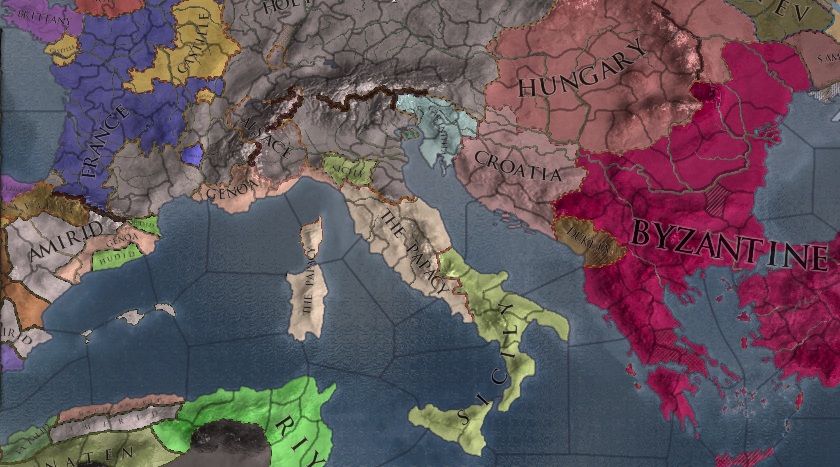
Southern Italy was firmly in the hands of King Godfrey I d'Hauteville, King of Sicily. Central Italy was the uncontested realm of King Carlo of Naples, the vassal of His Holiness Pope Agapetus III. The northern end of the Italian region was largely controlled by the Holy Roman Empire. Facing off against Kaiser Lutbert I von Metz was not an option, as the massive Empire controlled an overwhelming amount of land, wealth, and manpower -- as a result, the only viable option to expand the realm of the Pope and of Naples was to turn southward and finally tackle the Kingdom of Sicily.
=-=-=-=-=
So it's pretty much that time... Rolling over the various small duchies has generally been pretty simple... But trying to take the fight to Sicilyw ill be my first real test of this game, facing off against a big opponent with equal or greater resources than my own.
This should be a fun challenge




